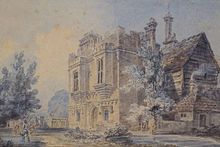Richard Rumbold | |
|---|---|
 Rye House, Hertfordshire, Rumbold's residence from 1660 to 1683; 1793 watercolour by J. M. W. Turner | |
| Born | 1622 Royston, Hertfordshire (possibly) |
| Died | 26 June 1685 (aged 62–63) Edinburgh |
| Allegiance | |
| Years of service | 1642–1659 |
| Rank | Captain |
| Unit | Cromwell's Regiment |
| Battles / wars | Wars of the Three Kingdoms Dunbar Worcester Argyll's Rising |
Richard Rumbold (1622–1685) was a Parliamentarian soldier and political radical, exiled for his role in the 1683 Rye House Plot and later executed for taking part in the 1685 Argyll's Rising.
During the Wars of the Three Kingdoms, he joined the New Model Army, and was one of the guards at the execution of Charles I of England in January 1649. He reached the rank of Captain before being dismissed from the army after the 1660 Restoration.
Closely involved with radical politics, he was implicated in the 1683 Rye House Plot, an alleged plan to assassinate Charles II of England and his brother James. After it was discovered, he escaped to the Dutch Republic, then took part in the 1685 Argyll's Rising, an unsuccessful attempt to drive James from the throne. Captured after being badly wounded, he was executed at Edinburgh on 26 June 1685.
His speech from the scaffold included the statement "none comes into the world with a saddle on his back, neither any booted and spurred to ride him." These words were quoted during the US Constitutional Convention in 1787, and by Thomas Jefferson shortly before his death in 1826.